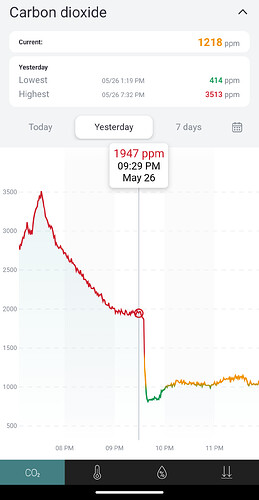Picked up a Aranet 4 monitor over the weekend not for the paincave specifically but of course I was going to test it…
This is from a 75 min ride in my paincave which is about 11x11 with 7ft ceilings, the door was open to my office (about same size) and the TV room, probably about 11x20 same ceilings height. There is another 11x20 unfinished space that I had the doors to closed (one off tv room one off paincave).
Initial green is from our bedroom (only me home/cleaning rest of house) and the bump is bringing it into the paincave. It went yellow (1000 ppm) almost immediately just from being in the room and went red (1500ppm) within 5 min of the ride starting. I did pause about 15 min from the end to fire up the pizza oven so that is the small dip a little before peak.
Obviously this is less than ideal but what has me worried more is how long it took to clear since the TV room is in the basement. This is 2 hours after I finished the trainer ride and went up stairs, door to upstairs was closed (like it usually is) so basically good news basement is sealed well, bad news is also basement is sealed well.
Will be looking into some wall mounted ERVs for the TV room and paincave apparently.
So now for why I actually bought it, testing the bedroom. It is ~13x16 with 8ft ceilings. We moved into this house in sept coming from a leaky non forced air 1850s house (this is 1960s). Like someone mentioned above 2 adults and a 2 year old, plus a dog. Since moving in none of us have slept well, I wake up to train early and way too frequently cannot find the energy/motivation to train just feel like garbage for an hour plus+ and run out of time to work out. We all just went through a nearly 2 month ordeal of sinus and ear infections, unresolved coughs etc. GF works from home, her mom stays with us to take care of the tot so the house is nearly always occupied.
We were not regretting the move, lead issues with the tot at the old house, the lack of sealing on a house that old was certainly not ideal for air quality and allergies so we were kind of shocked that we had been feeling worse in the new place. Windows are old (not 1850s but half are original), walls are 2x4, we weren’t expecting this to be so sealed up, which is good and bad as we are finding out since night time co2 was also an issue last night.
One of the dips in the red is someone getting up and then leaving bathroom door open.
2 of the other dips are me getting up to let dog out.
Final peak and then drop is when I woke up and left the bedroom door open to see how fast the room cleared out. Much better than the basement but never goes green, was still 1100 (yellow) when I left the house around 1pm.
We discussed looking into an ERV system before we even moved in and just thinking about plans for the house. There is some sort of incentive through the power company/state to get a blower door audit, free as long as you make like 100 bucks in repairs recommended. Since sleep is the second most important thing to my GF (after our daughter) we’ll be looking into all this sooner than later. Monitoring door open tonight, the dog is ~15 so we like to keep her from roaming and causing damage to the third most important thing to my GF… our floors.
Any previous posters make changes to help/have suggestions?




